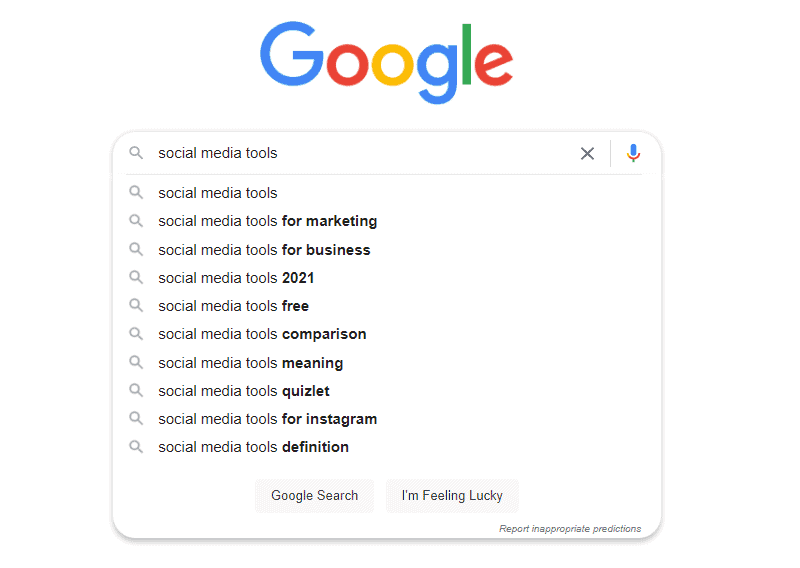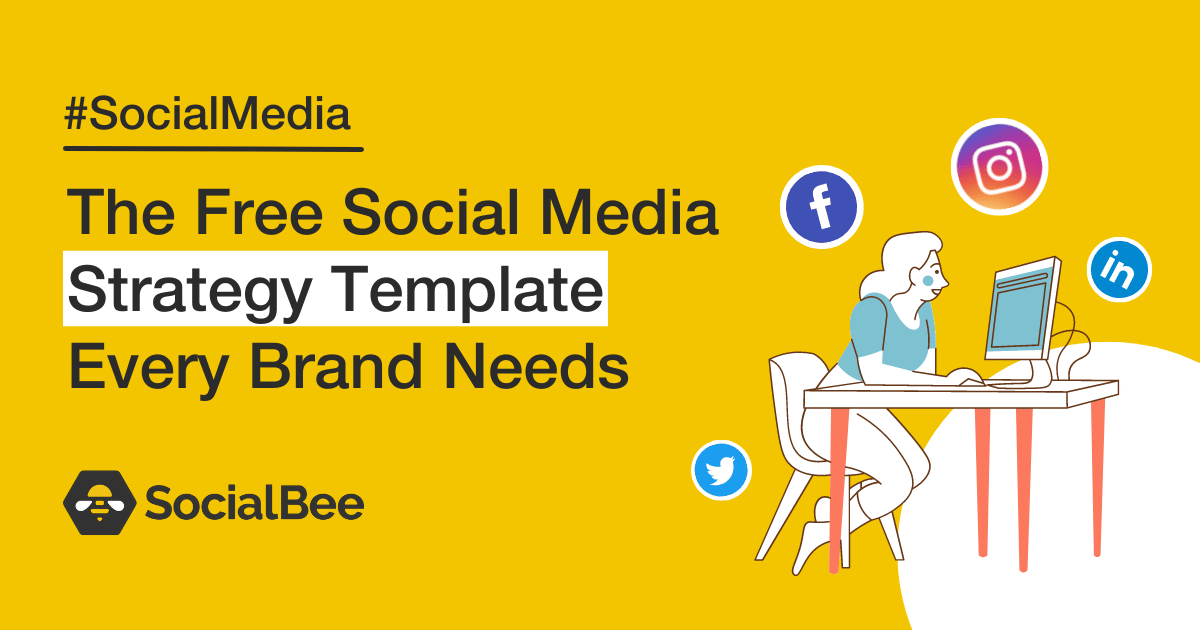
CONTENT WRITER
We know why you are here, and we are prepared with both a communications plan template and a guide that will help you every step of the way.
Communication plans are great strategies that will not only take your branding to the next level, but will also help you manage PR crises without damaging your image.
Here’s what we’ll cover in this article:
- What is a communication plan
- The benefits of a communication plan
- How to build a communication plan
- Three great communication plan examples
- A ready to use communication plan template
What Is a Communications Plan?
Communications plans are documents that outline the messages a business promotes, the audience meant for those messages, and the channels of communication.
A communication plan is a way to organize all your company’s messages in one place, define your goals, and ensure you maintain a consistent and positive image.
Moreover, it works as a foundation that will help with managing certain crises your company might face, pitching new ideas to your stakeholders, creating an effective communication strategy for a product launch, and more.
Free Communications Plan Template!
Download the template so you can put together a communication plan for your business faster and easier than ever.
The Benefits of a Communication Plan
Before we get into how to write a strategic communication plan, let’s see how such a document can benefit your business.
It Improves Client and Stakeholder Management
It Defines the Communication Process
Writing a clear communication plan will help you identify:
- What you need to communicate
- How you should share your message
- Who is the recipient
- Which channels are best for sharing certain messages
Also, this way, you will discover the unique characteristics of your intended audience. Consequently, you will understand their point of view better than ever before, and communicate with them more effectively.
It Creates a Positive Brand Image
An effective communication plan has a positive impact on your company’s image because it makes sure that every message you share with the public is correct, on-brand, and consistent on every communication platform.
Additionally, with the help of a communication plan, you can handle crises much more effectively. In fact, big brands have a designated crisis communication team ready to go in case of a social media controversy.
Having a crisis communication plan and planning ahead of time for emergency situations will allow you to manage the public perception better. Also, rushing your response in critical situations without clearly thinking it through will allow other mistakes to slip through and make the situation worse.
How to Write a Communications Plan
- Audit Your Current Communications Strategy
- Set Communication Goals
- Define Your Target Audience
- Develop Your USP and Mission Statement
- Find the Best Communication Channels for Your Marketing Efforts
- Assign Roles to Your Team Members
- Identify Your Key Stakeholders
- Write Down Key Dates for Your Communication Strategies
- Craft Key Messages for Your Audience
- Outline Your Communication Methods and Campaigns
- Put Your Communication Plan in Action
- Monitor and Adjust Your Communication Strategy
Now that you know what a communication plan is and how it can benefit your business, let’s get into the real reason why you are here — learning how to write an effective communications plan.
The first step to building a powerful communication plan is:
1. Audit Your Current Communications Strategy
Before you create your communication plan, you need to run a situational analysis of your current communication strategy.
Here is what you need to evaluate:
- Communication channels – List all the different channels you communicate on both online and offline with your audiences (partners, clients, project stakeholders, customers, etc.).
- Communication materials – Make an inventory of all your marketing materials. Include anything from flyers to social media graphics, as well as your permanent branding guidelines (color scheme, fonts, logos, etc.).
- Tone of voice and communication style – How would you describe your communication style? You can use several adjectives to define it.
- Results and performance – Which messages and communication platforms had the best/worst results. Add screenshots and links to understand the situation better.
To gather all this relevant information, you can go to the analytics you have for each communication channel, send surveys to your customers, partners, and stakeholders, and hold in-person meetings with your project team.
In addition, you can perform a SWOT analysis and discover both internal and external advantages and disadvantages:
👍 Strengths – Define what you do well, your best resources, and the aspects that give you an advantage over your competitors.
👎 Weaknesses – Focus on the critics you receive from others, the resources you lack compared to your competitors, and the areas that need improvement.
📈 Opportunities – Identify the opportunities and market trends that will allow you to transform your strengths into growth opportunities.
❌ Threats – Discover the external factors that can prevent your business from growing.
|
2. Set Communication Goals
Turn your business goals into specific communication goals. This way, your business needs will guide the way you think and write your communication goals. As a result, your chances of staying on track and enhancing your company’s performance will increase.
Your communication goals need to provide perspective and direction for you and your team. So, make sure you offer them all the details they might need.
When in doubt, respect the SMART goals structure:
- Specific – State what you want to accomplish and how you plan to do it.
- Measurable – Mention how you plan to measure your progress.
- Achievable – Be realistic, and set goals that are achievable based on your company’s resources.
- Relevant – Write communication goals that align with your business needs.
- Time-bound – Keep your team accountable by setting a clear deadline for your goals.
Here is an example of a SMART communication goal:
| “Improve customer satisfaction in the next 6 months by replying to every review, comment, email, and message within 24 hours.” |
To measure success, you will have to check the reviews and feedback you receive as a result of your new initiative.
3. Define Your Target Audience
In order to write effective key messages, you first need to understand your target audiences. This doesn’t only include your customers but also your employees, partners, investors, government officials, media outlets, and more.
As a result of your research, you will be able to craft perfectly tailored messages while also discovering their preferred communication channel. Feel free to ask for feedback and suggestions that will improve their experience as well as your collaboration. Also, keep an eye on the way they communicate and try to match their approach.
When it comes to customers, you have other tools and analytics you can use to get more insight, like Google Analytics and social media data.
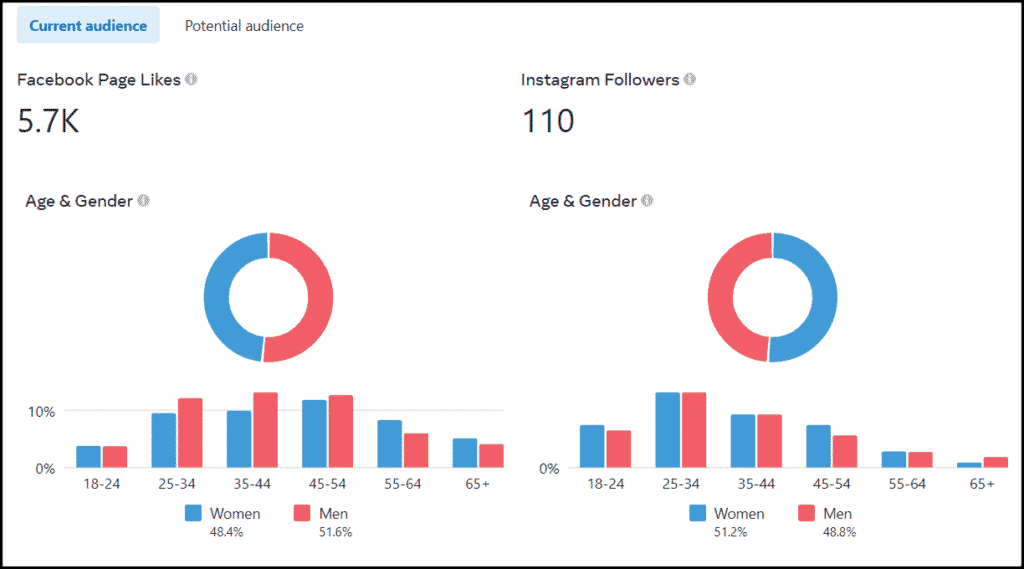
Based on the information you gather, you can create detailed buyer personas — fictional characters with the traits of different segments of your target market.
In this way, you structure all the audience data and make it easier for you and your team to remember.
Here is what a buyer persona should contain:
- Name
- Demographic information
- Interests
- Behavioral traits
- Pain points
- Goals
- Values
- Buying habits
- Needs
- Desires
The goal is to reach the right people with customized messages that will resonate with them.
4. Develop Your USP and Mission Statement
Not all businesses are built the same. And this is a good thing.
Your unique selling proposition is very important for your communication plan, especially when it comes to your promotional content. Why? Because you have to rely on that unique quality to differentiate your business from the competition and give your customers a reason to purchase from you.
To develop your USP, you first need to answer the following questions:
- What do you provide that your competition doesn’t?
- What customer issue do you solve through your business?
- Why should your customers choose you and not your competitors?
Furthermore, while your USP works as a way to make your brand stand out from the crowd, your mission statement provides meaning and purpose to your company.
A great mission statement reflects your customers’ values and provides an additional reason to invest in your products.
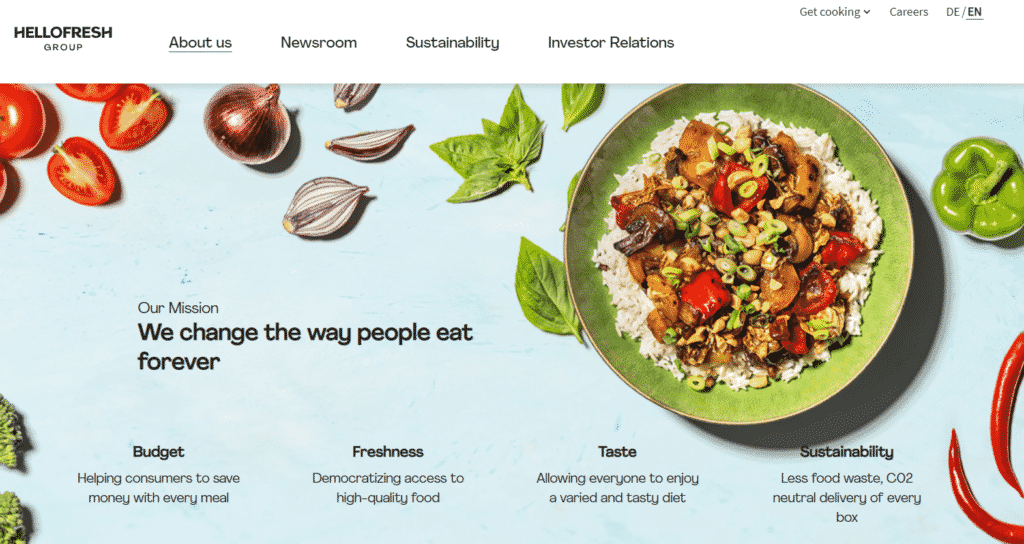
Let’s say you sell sweets. Your USP is that you don’t use sugar in your products. So, in your mission statement, you could state that through your business, you aim to provide healthy and delicious dessert alternatives and improve your customers’ lifestyles without compromising the taste of your sweets.
5. Find the Best Communication Channels for Your Marketing Efforts
It’s not only essential to know how to communicate with your audience, but also to discover the channel that you should use to reach them. Moreover, for better results, you need to keep your communication separate.
For instance, with your stakeholders, you can plan online or in-person meetings and provide project reports regularly. Whereas, with media outlets, you can move your communication to email. All you need is to have the contact information of several relevant journalists and nurture your media relationships on this channel.
The same goes for the rest of your audience segments. The more you customize your communication to fit your audience’s needs, the more success you will have.
However, when it comes to your customers, you have more options. You can get creative with your communication when promoting your business.
So, let’s have a look at the main communication channels you can use to connect with your customers.
Content Marketing
Your communication plan wouldn’t be complete without including your content marketing strategy.
In fact, did you know that 70% of customers would rather learn about a business from an article or blog post than from advertisements? So, it’s safe to assume that content marketing is quite a big deal.
This marketing strategy is used to attract, engage, and maintain customers by creating and distributing relevant content (articles, videos, social media posts).
Apart from this, content marketing helps businesses establish themselves as credible and authoritative sources of information, build brand awareness and stay top-of-mind.
So, make sure you include your social media platforms, your blog, and other content creation platforms (Youtube, Udemy, etc.) and give details about your communication strategy on all of them.
Don’t forget that with SocialBee you can create, edit, schedule, and share content on all your social media platforms from one user-friendly dashboard.
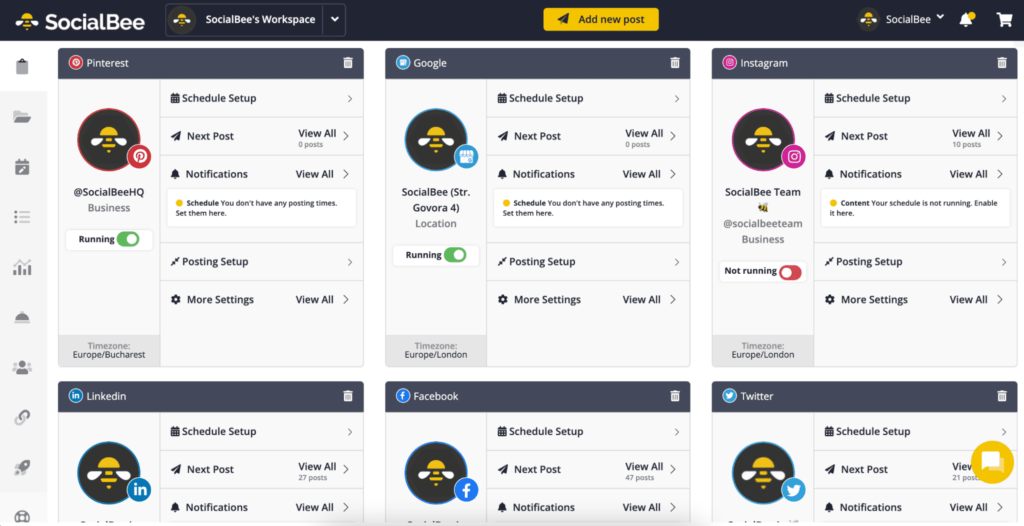
Besides, SocialBee can generate automatic social media posts whenever you publish a new article, making the most out of your content marketing strategy.
Don’t miss out on a 14-day free SocialBee trial!
Post on Social Media with SocialBee!
Search Engine Optimization
To optimize your communication plan and make sure your customers see your content, you must perform search engine optimization. Statistics show that 68% of website traffic is generated by search engines, a great insight for businesses.
A good practice is to make a list of all the keywords your audience may use to search your products and services and add them to your communication plan. As a result, you will have them ready to use whenever you create content for Google.
Make sure to use keywords and key phrases that match your customers’ search intent, and combine both short-tail and long-tail keywords into your strategy.
Moreover, add them to your titles, headings, meta descriptions, image alt text, and body text.
Email Marketing
Email marketing is a great way to not only generate new leads, but also nurture your relationship with your existing customers. You should also know that email marketing has an average ROI of $36 for every dollar spent.
It’s an essential part of your communication plan, so ensure you create a messaging strategy that will gain you more website traffic and keep your audience in the loop regarding company news, promotions, and newly posted blog articles.
Influencer marketing
Amplify your messaging strategy with influencer marketing.
This marketing practice is used to generate brand awareness, gain trust, and improve sales.
The key is to find relevant influencers from your industry that your audience looks up to.
Aside from that, you need to pick people that fit your image and share the same values if you want influencer collaborations to work. As a result, you will have a partnership that seems genuine and addresses the right audience.

Make a list of online personalities that you could collaborate with, and add them to your communication plan in the timeframes when you assume you will need a boost in visibility and sales.
Affiliate Marketing
Affiliate marketing is another practice you can use to share your message with a larger audience. It involves paying other bloggers to promote your business on their website through link insertions, product/service reviews, and articles.
Besides, it’s an affordable way to generate traffic, boost sales and brand awareness, and build authority within your industry.
6. Assign Roles to Your Team Members
You know your audience, and you picked the communication channels you will use, so it’s time to assign some roles to your team members.
For example, when it comes to communicating with media channels, you will need to assign a team member to prepare press releases and keep in touch with journalists.
Make sure you add your key team members along with their roles in the communication plan. This is useful for everyone on the team because:
- They know what their responsibilities are ahead of time.
- They know who to go to in case they need help or information.
Free Communications Plan Template!
Download the template so you can put together a communication plan for your business faster and easier than ever.
7. Identify Your Key Stakeholders
As a business, you will have to run and manage multiple projects. And for some of them, you need the support of your stakeholders in order to be successful.
As you can imagine, this means that you need to maintain a fruitful and transparent relationship with your stakeholders.
This is why you should add them to your communication plan. You should also include all your project deliverables, stakeholder information, and the main ways you plan to keep in contact.
8. Write Down Key Dates for Your Communication Strategies
Every business has peak moments throughout the year when their sales increase and the demand for their product rises, like flower shops during Valentine’s Day.
Some of them are obvious, while others require a little more digging through the data. So, start looking at your sales history from the past year and identify your most profitable intervals.
With this information, you can adjust your communication planning and improve the way you communicate with your customers. Plan some promotions, create new email campaigns, run ads, basically do anything that can increase the visibility of your business.
Furthermore, you should also research holidays or international celebrations you can use to promote your brand.
9. Craft Key Messages for Your Audience
For this step, you have to keep your audience in mind at all times. It’s essential that you create key messages that fit the needs and desires of your customers.
To customize your messages accordingly, you need to answer the next questions:
- What should your audience know about your company?
- What language and communication style would your audience prefer?
- What are the main benefits you should highlight?
- What values resonate with your customers?
Make separate sections for each segment of your audience and add your key messages into your communication plan.
Create a Messaging Matrix
We advise you to create a messaging matrix in order to define your communication strategy for each. This requires you to separate your audience into segments and create categories of key messages and channels you will use for that group.
For instance, let’s say you sell skincare products and your two main target audiences are young girls between 14 and 20 and women between 30 and 45. The girls encounter problems like acne and dry skin, while the women see signs of aging such as wrinkles and depigmentation.
So you decide to address their issues and promote products that will provide a solution. With the girls, you can communicate on Instagram and TikTok, while with the women you can go for platforms like Facebook.
10. Outline Your Communication Methods and Campaigns
Your action plan is the meat of your communication strategy.
In order to establish the main activities of your communication plan, you first have to follow these three steps.
Align Your Communication Plan With Your Marketing Calendar
Take a look at your marketing calendar, and find out what your marketing team has planned to improve your company’s performance. Then create your customer communication strategy to increase the results of those marketing initiatives.
Create Communication Campaigns
To organize all your marketing activities and keep track of your progress, you must plan different communication campaigns throughout the year.
This means that you must establish:
- A theme or a goal that provides purpose and direction.
- Strategic activities that will help you achieve your goals.
- Clear dates for the beginning and the end of your campaigns.
Plan Activities to Achieve Your Communication Goals
The activities you include in your communications plan should be aligned with your communication goals. After all, you want to accomplish them in a certain time frame.
That being said, your communication tactics should deal with the following aspects:
- Where will you share your message
- How will you communicate it
- When/how often will you communicate
11. Put Your Communication Plan in Action
Now that you included all the necessary elements in your communication plan, it’s time for action.
It’s a good idea to share your plan with your team and go over it together to ensure that everybody is on the same page before you implement it.
12. Monitor and Adjust Your Communication Strategy
Your communication plan is a work in progress, it’s not a finished product. So, establish a few monitoring tactics that will allow you to track your success and identify mistakes that affect your business’ growth.
Gather all your analytics, create reports, and hold meetings with your team to gain feedback and find solutions for potential issues. You should also use the communication goals you previously set to find out if you are on the right track.
Communication Plan Examples
To give you a better idea about how you should structure your strategy, we prepared three examples you can take inspiration from:
- A project management communication plan from VENNGAGE.
- A strategic communication plan from Lean Methods Group.
- A communication plan example from TemplateLAB.
First, we have a project management communication plan from VENNGAGE. You can see that it has a deadline, an assigned project manager, business objectives, tools, audience information, and messaging frequency. Also, the nice colorful design is a plus.
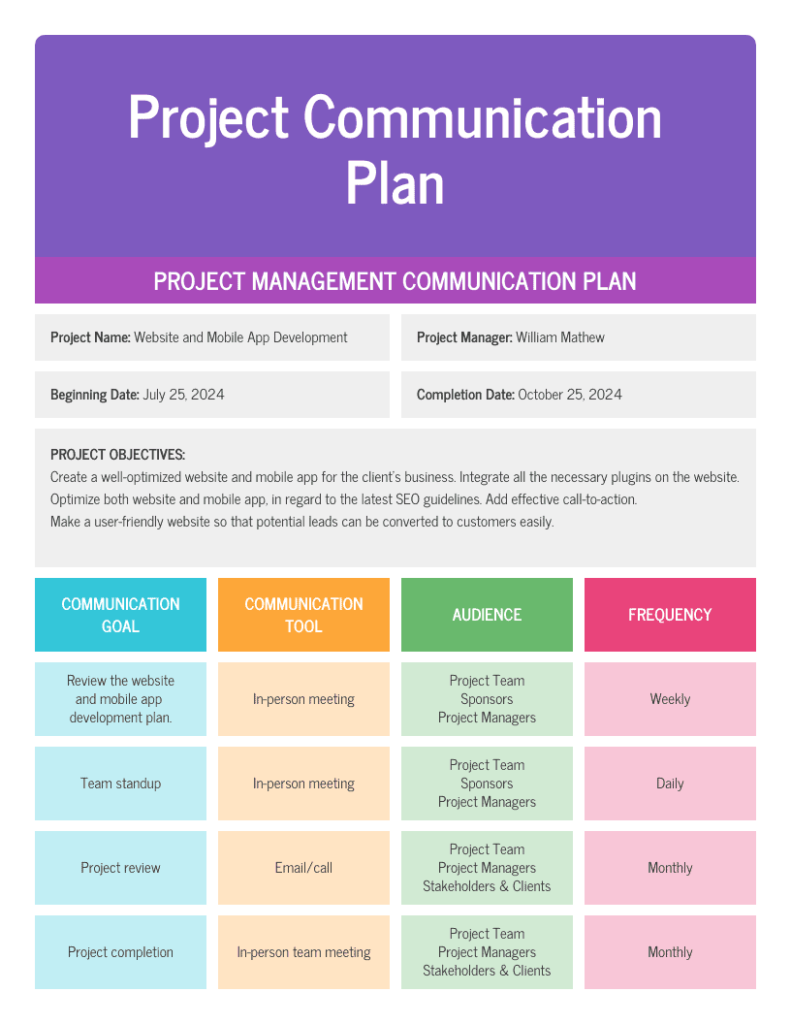
The next communication plan template is from Lean Methods Group, and it provides details about:
- Audience
- Message(s)
- Media or vehicle
- Frequency
- Timing
- Assigned team member
- Feedback mechanism
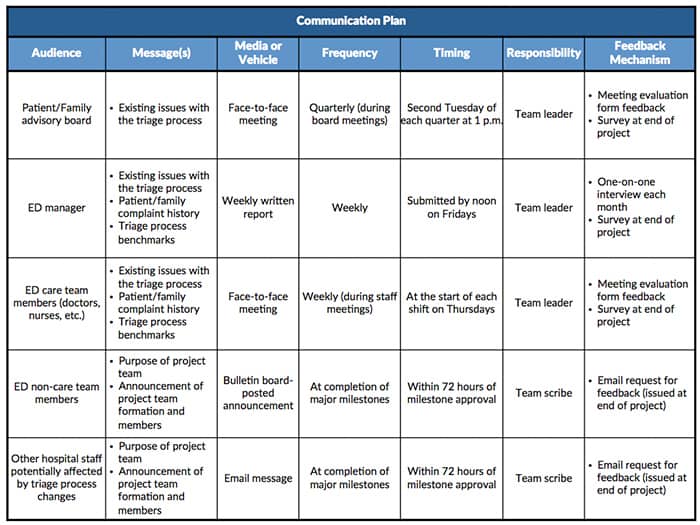
This last example is a communications plan template from TemplateLAB that contains information about audience segments, key messages, means of communication, and deadlines for each initiative.
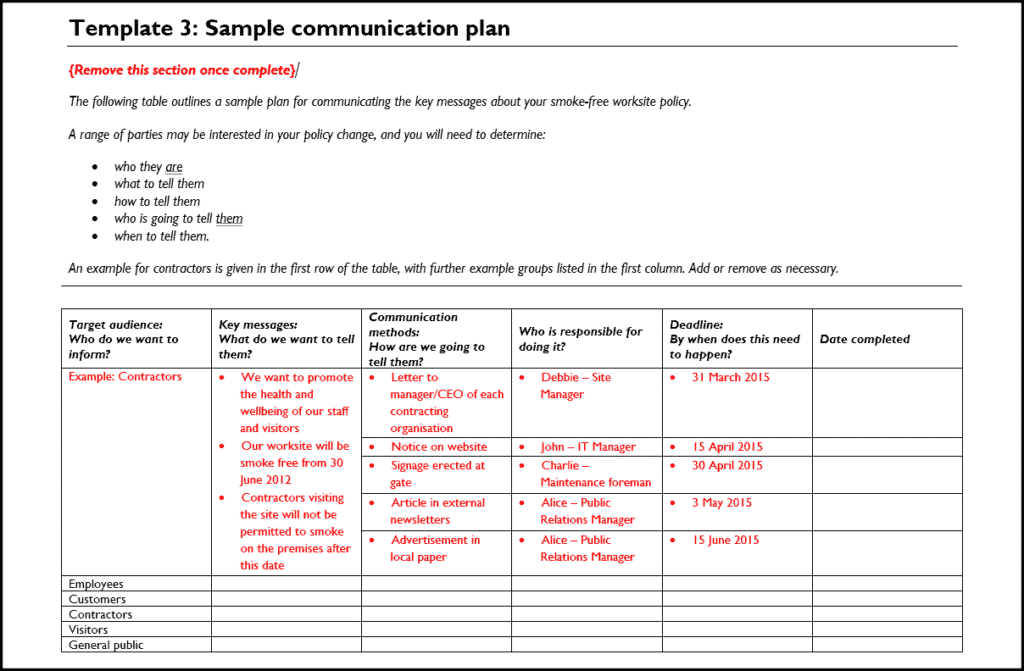
Although these are great documents you can use in your communication plan creation process, we have an alternative that will save you hours of work.
So, make sure you access our free template below, make a copy, and add your magical touch.
Make the Most Out of Your Communication Plans
Now that we went through what a communication plan is, its benefits, and the necessary creation process, we reached the end of this article. However, it’s only the beginning of your work.
But don’t worry, our template is waiting for you, ready to give you a head start on the competition. Just access it below and let us know if you enjoyed our communication plan example.
Free Communications Plan Template!
Download the template so you can put together a communication plan for your business faster and easier than ever.
